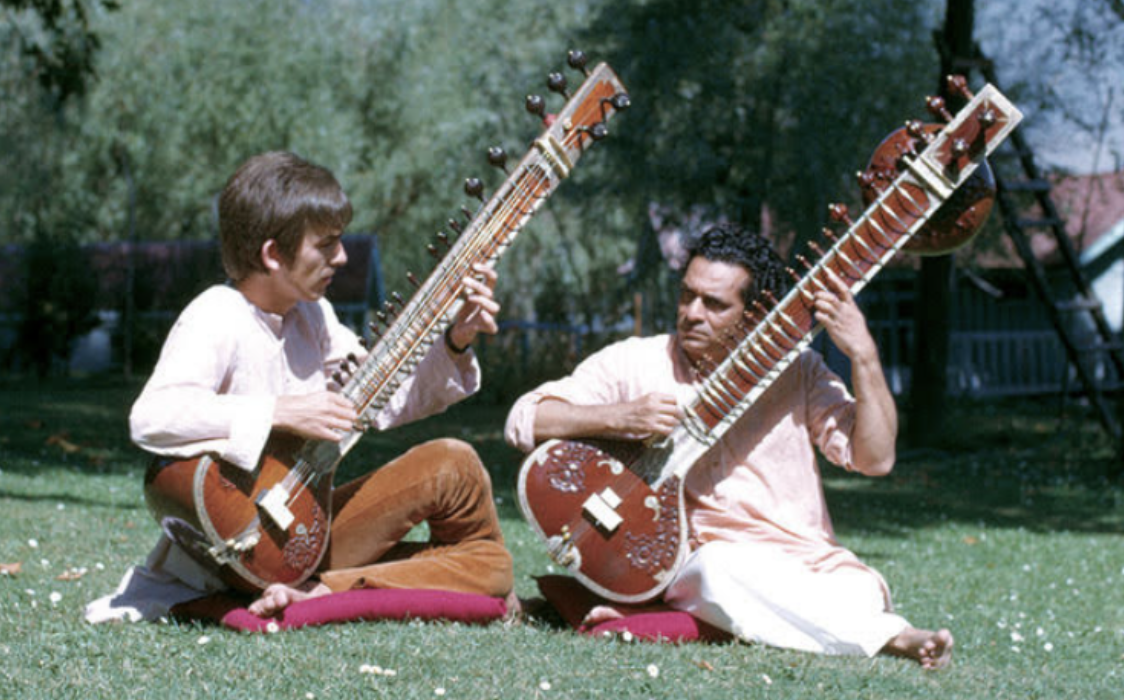With a hollow base carefully crafted of dried pumpkin, a neck made of teak wood, and twenty metal strings colored gold, the sitar is a musical instrument that perfectly encapsulates the beauty of South Asian culture. If you’ve walked into an Indian restaurant or watched a Bollywood movie, chances are you’ve probably heard the ethereal resonance of the sitar. No instrument exudes opulence and royalty quite like the sitar.
It was Norwegian Wood by the Beatles that first opened my eyes to India’s massive influence on classic rock.
Typically measuring around four feet in length, the sitar’s pear-shaped body holds twenty movable frets and roughly twenty strings – a combination of melody, droning and sympathetic strings. It is played while seated, using a pick called a mizraab. It is safe to assume the instrument was invented by Amir Khusrow, a famous Sufi inventor, poet, and pioneer of Qawaali music. Adapted from the long-necked lutes taken to India from Central Asia, the sitar flourished in the Indian subcontinent in the 16th and 17th centuries, soon becoming the instrument we know today.
The sitar has been around for roughly 400 years, and is traditionally used in concerts for royalty and special religious ceremonies. However, it wasn’t incorporated into Western music until the music of Ravi Shankar came to prominence. Ravi Shankar, a member of a scholarly Bengali Brahmin family and student of mentor and composer Allauddin Khan, was a man who can be best remembered for his creativity and open-mindedness that was prevalent throughout his entire musical career. He displayed his sitar prowess from his debut at Carnegie Hall in 1961 to the Monterey Pop Festival in 1967 to Woodstock in 1969. No one could quite capture the beauty of Indian raagas like he did. Though classical Indian music is a largely oral tradition with no sheet music involved, Shankar is credited with developing a new notation system for sitar during the 1950s.
In 1966, the music industry was forever changed the moment when Shankar befriended George Harrison, lead guitarist of the Beatles. By this time Harrison had already recorded the famous Norwegian Wood, which first appeared on the band’s 1965 album Rubber Soul, the first Western pop song to incorporate the sitar. He was enthralled by the instrument a year before, when someone decorated the set for the Beatles’ film Help! with a sitar. After meeting Shankar, he became painfully aware of the ineptitude of his own training and traveled to India for six weeks to take biweekly lessons from him.
Shankar and Harrison in the 1960s
Shankar agreed to train Harrison because of the immense passion and humility he expressed regarding his knowledge of the sitar. That being said, Harrison was also completely unaware of basic etiquette in Hindustani music. He once stepped over his sitar to answer the phone, and Shankar was horrified. Showing utmost respect for your instrument is one of the most important rules in India.
“Ravi was my link into the Vedic world,” Harrison recalls. “Ravi plugged me into the whole of reality.” “Vedic” refers to the Vedas, which are traditional Hindu scriptures.
In 1966, the term Raga rock was coined, referring to rock music with a pronounced Indian influence. The Beatles had started a trend. American instrument manufacturer Danelectro introduced and manufactured the electric sitar in the late 60s that was used in many rock songs. It was meant to make it easier and more accessible for Western musicians, as traditional sitars were expensive and extremely difficult to master. The electric sitar combined the familiarity of the guitar with the twangy sound of the sitar.
In May 1966, the Rolling Stones issued the raga rock single Paint It Black, which featured a sitar part played by guitarist Brian Jones. It became an international number 1 hit. Jones actually picked it up before Harrison. Music with South Asian influences quickly became all the rage. Catchy sitar riffs were the quintessential sound of psychedelic rock. The Doors had also famously used mostly Indian scales in their albums, often using other instruments, along with the sitar to provide a groovy backing track to their songs. Other prominent examples include Tomorrow’s Real Life Permanent Dream, Traffic’s Paper Sun, The Monkees’ This Just Doesn’t Seem to be My Day, and later, ABBA’s I Have a Dream and Red Hot Chili Peppers’ Behind The Sun.
Shankar expressed that “It is strange to see pop musicians with sitars. I was confused at first. It had so little to do with our classical music. When George Harrison came to me, I didn’t know what to think, but I found he really wanted to learn. I never thought our meeting would cause such an explosion, that Indian music would suddenly appear on the pop scene. It’s peculiar, but out of this, a real interest is growing.”
By the time Sgt. Pepper’s Lonely Hearts Club Band was released in 1967, Harrison had found his own voice on the sitar, using techniques he learned from Shankar to express his creative genius. Within You, Without You, a song about the search for transcendental peace and living an ego-free existence, stands as one of The Beatles’ most successful attempts at embracing both South Asian sounds and philosophies. George Harrison’s My Sweet Lord is another good example of this.
The song enchanted a generation of Western listeners and introduced them to the world of Indian classical music. It resulted in a fascination with Indian mysticism, meditation and yoga. Suddenly, the mind-expanding philosophies began to be associated with mind-expanding drugs.
Shankar didn’t disapprove of popular musicians’ embrace of his sacred instrument, but he did not appreciate the association of his rich cultural heritage with drugs like LSD. In a 1985 interview he said, “On one hand, I was lucky to have been there at a time when society was changing. And although much of the hippie movement seemed superficial, there was also a lot of sincerity in it, and a tremendous amount of energy. What disturbed me, though, was the use of drugs and the mixing of drugs with our music. And I was hurt by the idea that our classical music was treated as a fad – something that is very common in Western countries.” It was important for Shankar to uphold the precious ancient traditions of the sitar while also encouraging cultural amalgamation.
The ways in which music can connect people is something truly worth celebrating. It is refreshing to see musicians acknowledging their influences and giving credit where due, which shows us the beauty of cultural appreciation. Elsa Lyons (V), co-leader of Music Appreciation Club, says that “I think the eclecticism of The Beatles and their openness to experiment was the key to their success and mass influence.” Shankar and Harrison’s friendship brought two worlds together and opened doors for artists all over the world to create cross-cultural fusion music. South Asian influences can still be heard in music today, meaning someone else out there is bound to feel the same way I felt when I first heard Norwegian Wood.







i must censor myself but, **** YEAH! this is awesome!!!!
Epic article, a must-read for anyone who loves music and the arts.